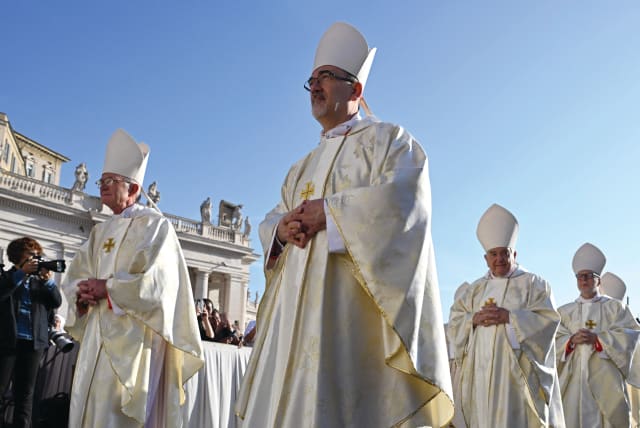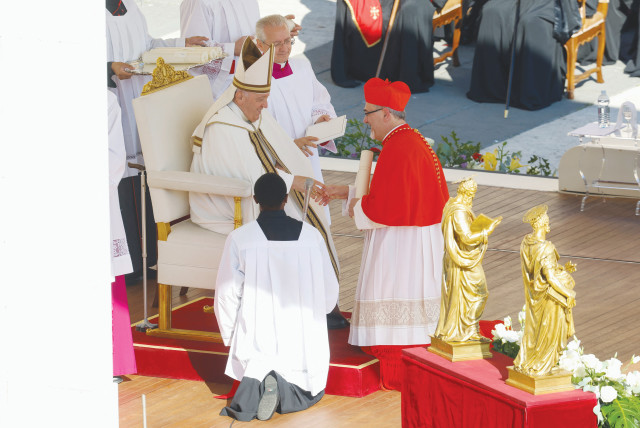When a hassidic rabbi traded himself to save Jewish hostages

While the cardinal likely knew of the biblical precedent of his offer, it is less likely that he was aware of the hassidic tradition of a religious leader who did trade places with a captive.
Cardinal Pierbattista Pizzaballa (b. 1965), the Latin patriarch of Jerusalem and the highest Vatican representative in the Holy Land, has not been a vociferous supporter of Israel. However, on October 16, 2023 – just over a week after the brutal massacre and inhumane deeds of Hamas, which included taking defenseless people hostage – the cardinal responded to Italian reporters’ questions by saying: “Am I available for an exchange? Anything, if this could bring about the freedom of children, no problem. My absolute willingness.”
The cardinal’s offer to exchange himself for captive Israeli children held in Gaza was widely reported in the press. However, the cardinal – who is responsible for Roman Catholic activities in Israel, the Palestinian Authority, Jordan, and Cyprus – noted that his office had not had direct communication with Hamas. “You can’t talk to Hamas. It is very difficult,” he explained. Since then, it is not clear whether the Vatican or some other arm of the Catholic Church officially communicated the cardinal’s offer to the terrorist organization. So when the cardinal said he would do “anything” to “bring to freedom and bring home the children,” it is not clear what he meant.
Of course, the notion of bravely taking the place of another hostage was not the brainchild of the cardinal. In the Book of Genesis, Judah sought the release of Benjamin from captivity by offering to take his place: “And now, please let your servant remain as a servant to my lord instead of the boy, and let the boy go back with his brothers” (Genesis 44:33). Judah directly addressed Pharaoh’s viceroy (Joseph!), and his offer was so heartfelt that Joseph could no longer keep up the charade, and he emotionally revealed his identity.
While the cardinal likely knew of the biblical precedent of his offer, it is less likely that he was aware of the hassidic tradition of a religious leader who did trade places with a captive.
The hassidic tradition of saving hostages
REB ARYE LEIB of Shpola (1724-1811) – known as the Shpoler Zeide, “the grandfather from Shpola” – was a famous dancer. When asked about his dancing dexterity, he explained with a grin: “Elijah the Prophet taught me well!” Rabbi Yehuda Yudel Rosenberg (1859-1935), a fantastic 20th-century storyteller, recounted how the Shpoler Zeide told of his journey to dancing prowess:
“A magnate imprisoned a Jew who had not paid his dues. He languished in a pit; bread and water were lowered to him once a week. There he waited until the magnate’s birthday party, when he would be forced to dance before the guests. This dance was a public ridicule for the prisoner, as well as a judicial duel, as the Jew was forced to compete in a dance-off against someone else. Not only was the Jew weakened from his time in the dungeon, but he was dressed in a bear suit, with a metal chain around his neck, and his competitor acted as the bear trainer.
“A particular dance was chosen, and the rules were announced before the dance-off began. There were three possible outcomes. If the bear matched his trainer and amused the audience, then the Jew would be released. If the bear outdanced his trainer, he could attack the trainer like a real bear. If the bear did not outdance his trainer and did not even entertain the audience, then the trainer would lead the bear to dance with dogs.”
Readers were not left to guess what it meant to “dance with dogs,” as the narrator explained that magnates’ courtyards were filled with vicious canines. If a person was thrown to the dogs, they would tear him apart.
The competition was stacked against the Jew: He had not had a proper meal in days, he was forced to wear a cumbersome bear suit, and he had no training in the art of dancing.
The Shpoler Zeide continued: “I was visited by Elijah, who instructed me to go to a certain village and hire myself out as a teacher. I was to gather information so that I could save the Jew by swapping places with him. But I told Elijah: ‘I don’t know how to dance at all! If they tell me to dance a Kozachok and I offer some other dance, it will not end well.’
“In response, Elijah taught me how to dance. He taught me one dance step at a time until I was an adroit dancer just like the nobles.
“In the meantime, I found a way to enter the magnate’s gardens, and I realized that it was possible to enter the dungeon but that it was difficult to get out. Once the dance-off was scheduled, I snuck into the prison area armed with a rope, wood, metal pegs, and a hammer. I stole through the garden and lowered myself into the pit.
“The imprisoned Jew was frightened. ‘Fear not!’ I said to him, ‘for I have come to save you.’ I explained what I was planning for the next night. We swapped clothes – I took his ragged coat, and he took my coat. I told him that when they open the door and call his name, he should hide and I would go in his stead. With no one else in the dungeon, they would not lock the door, and he could escape.
“When they came to fetch the prisoner, I crawled out so they would not recognize me. I groaned and spluttered to show that I could not walk properly. They laughed and threw the bear suit on me.
“I was brought in amid jeering, and the rules of the trial-by-dance were announced. The musicians began to play a Kozachok, the trainer danced, and then signaled that it was my turn. Sure enough, I outdanced the trainer, who was shocked. The musicians then played a mazurka, and again I bested the trainer. The trainer was tipsy, and when we circled, he fell down.
“I pounced on top of him. Mayhem broke out. I was pummeling him, he was screaming, onlookers were encouraging me. Two people begged for his life, promising me that I could go. I relented and fled the scene, still dressed in the bear suit.
“You see,” concluded the Shpoler Zeide, “now you know why I dance so well – because I had a good teacher!”
One of the Shpoler Zeide’s colleagues, Rabbi Avraham (1741-1776), known as “The Angel” for his ascetic practices, responded: “If so, your dancing is better than my prayers.”
RETURNING TO our own reality: Cardinal Pizzaballa’s offer was not taken up; and as we know, our brothers and sisters are still being held captive, and we pray – and perhaps dance – for their release. ■
The writer is a senior faculty member at the Pardes Institute of Jewish Studies and a rabbi in Tzur Hadassah.
Jerusalem Post Store
`; document.getElementById("linkPremium").innerHTML = cont; var divWithLink = document.getElementById("premium-link"); if (divWithLink !== null && divWithLink !== 'undefined') { divWithLink.style.border = "solid 1px #cb0f3e"; divWithLink.style.textAlign = "center"; divWithLink.style.marginBottom = "15px"; divWithLink.style.marginTop = "15px"; divWithLink.style.width = "100%"; divWithLink.style.backgroundColor = "#122952"; divWithLink.style.color = "#ffffff"; divWithLink.style.lineHeight = "1.5"; } } (function (v, i) { });

